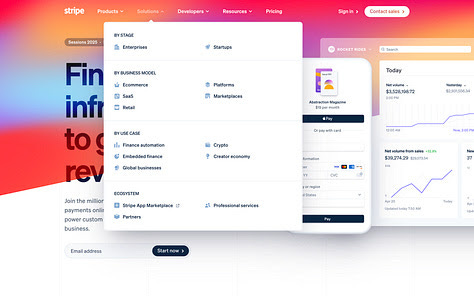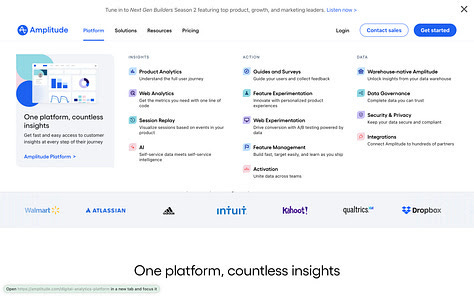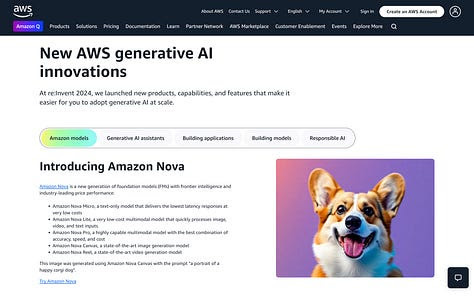Readers know I’m a big fan of platform thinking and have a lot of respect for platform PMs, which is why I was excited when Waqas Sheikh (of Waqas’s Musings) reached out to collaborate on a post on that topic. The job of platform PMs can be confusing both for the individual and the stakeholders, and our hope is this essay equips folks with more perspective; for practitioners that means a path to mastery, and for peers a path to partnership.
The enigma of the “Platform PM”
The Platform PM is arguably one of the most valuable yet least understood roles in tech today. At the risk of sounding hyperbolic, this is a sentiment we’ve both felt at various stages of our careers leading platform products ourselves, working with organizations that are developing the platform muscle as they scale. Whether a company is expanding its portfolio or extending its product into a broader ecosystem, platform PMs are a key part of executing successfully.
In fact, so enigmatic is this Platform PM role, that one of the first questions we asked ourselves at the start of this collaboration was whether we had the same definition of “platform product management” for ourselves - the provocation for this prompt a while back👇
Suffice to say, there was no single, unified perspective from respondents. In fact, a number of responses trended towards “both” and “all of the above”!
In today’s essay, we will try to unpack the essence of the platform PM role at a level that may resonate with many of you, irrespective of whether you consider yourself a platform PM, manage them, or work closely with them. Our hope is that you take away from this is an understanding of:
Why this role is so critical to organizations that need to scale & mature
Why mastering it is really hard since it tests nuanced, unique aspects of the PM craft
Why we expect platform product management to grow in importance over time (as we enter the AI era)
The motivation behind platform products, and PMs to lead them
Imagine a thriving product organization. Let’s imagine they have the gift of a core product that has strong PMF with its target segment, leading to impressive user growth & retention. They have found a business model that is both viable & sustainable, instilling confidence in the company’s long-term growth trajectory. Perhaps the org is rapidly scaling the team, bringing on newer disciplines and team-members to focus on various facets of the product and GTM.
The unique privilege that this org has earned is the ability to think in terms of strategic product capabilities, and how & where to deploy them. Orienting around capabilities can be a huge unlock, because it makes it easier for organizations to envision and pursue more ambitious strategic goals & opportunities ex:
Expanding reach into a wider ecosystem of potential user segments and/or powerful integrations with strategic partners
Evolving towards a multi-product portfolio that can win adjacent markets or segments to the core product
Accelerating product innovation through M&A
Maximizing productivity & velocity by centralizing internal-facing tools & platforms
Thinking strategically in terms of platform & capabilities is a different muscle than thinking in terms of features & solutions; rather than creating value for a specific user persona or providing a solution for a specific use case, platform thinking involves forecasting how adjacent personas will converge and how to set up the next wave of PMF. Platform thinking is anchored in breadth more so than depth. And the need for this type of broad, platform thinking goes far beyond the more technical roles like engineering or data sciences. For Platform PMs, it means that there are some unique skills & traits you will exercise more often than other PM archetypes you may come across (ex: Growth PMs, Feature PMs, Innovation PMs…) -
Rationalizing strategic priorities across a variety of contrasting time-horizons and competing strategic goals.
Understanding and synthesizing needs across the breadth of the product portfolio.
Product rigor and technical depth to be able to balance value creation for customers & business with investments needed to advance & mature the platform infrastructure.
Relationship building and conflict resolution across a wide “social graph” of stakeholders and leaders through an organization.
Influential, thoughtful communication so you can flex how to navigate dependencies across a diverse audience.
Mastering any one of these skills & traits can be hard enough. Accumulating all of them is quite rare, and takes a lot of time & commitment. Being able to demonstrate them all across a wide range of companies & domains is incredibly unique. But as you might imagine, organizations put a premium on PMs & PM leaders who can manifest it for them. Even a cursory look on LinkedIn gives you a sense of the demand out there…
Platforms, platforms, everywhere!
Mastering the craft - and tensions - as a Platform PM
There seems to be a dearth of guidance, best practices or content available to platform PMs to develop mastery and excellence in their roles. This is in stark contrast to other PM archetypes (ex: Growth PMs, Feature PMs, Innovation PMs…) where practitioners can learn a lot from expertise available broadly beyond just learning on the job. While contexts, circumstances & challenges will vary, we believe there are at least 3 differentiated skill areas that you need to master to develop craft as a long-term platform PM. We see these as unique extensions and extrapolations of the core, general PM skillset, but applied specifically to a platform context -
Understanding your customers (no, really)
Solving the Rubik’s Cube of platform strategy
Communicating hard things, so they feel easy
1. Understanding your customers (no, really)
A truism about platform product management is the need to serve or support multiple stakeholders & users, internally and/or externally. For external-facing platform products, this comes in the form of threading the needle between the needs of end-users, external partners and internal stakeholders. For internal-facing platforms, this comes in the form of triangulating divergent needs across business units, functional disciplines and leadership.
Stakeholders, stakeholders everywhere!
A complex stakeholder map like this presents a number of potential pitfalls for platform teams; ones that a skilled platform PM can help mitigate and prevent.
For example, proximity bias can sometimes lead to internal stakeholders being treated or perceived as if they were primary customers. This is especially true if they have a prominent voice or power in the organization. This can lead to a pattern where their goals & needs are seen as P0 by default, even if they’re not the best overall use of the platform’s investment or resources. This dynamic can also force your platform team to operate like a service team whose job is to tick-off as many asks from the client as possible.
Related, especially for internal platform teams, a common mistake is to defer too much to their internal stakeholders to act as the voice of the user for them. While this may be well-intentioned, for platform PMs, it’s important to remember that even being one step removed from end users can be an ocean part in terms of your level of empathy and intuition about them. Nurturing their product sense is on them, even if it takes more effort to connect-the-dots and build deeper insight.
As Richa Verma eloquently shares, “a platform PM has to prioritize a user's user”. Their mindset needs to be to pursue the global optima in terms of outcomes, over all else. The core job of the platform PM is to maximize cumulative, long-term impact on end-users & the business, through the development and usage of the platform product. Operating with this mindset encourages you to be strategic in how you set goals & prioritize work, and opinionated in how you build relationships & influence your stakeholders. In fact, when an organization is misaligned on strategic prioritization, the platform PM is likely the first to notice, serving as a canary in the coal mine.
2. Solving the Rubik’s Cube of platform strategy
Platform products are powerful because they can create real business impact in multiple ways: growth through new capabilities & use cases, retention through reliable, maintained systems that get better over time and margin expansion through streamlined workflows and lower total cost-of-ownership (TCO) in the long-term.
But the very fact that platforms can be valuable in many different ways is also the reason that platform strategy can be hard to develop & align others around. Not to mention that while the idea of building generalized, extensible platform capabilities is great, the upfront development costs can be very high when the platform is immature. For platform PMs, it can feel like a rite-of-passage to find themselves in situations where their roadmaps, prioritization & approach are under siege by stakeholders or leadership -
“Why are my needs being deprioritized? We need this done sooner!”
“How do we know we’re making the right build vs. buy decisions here?”
“I know we’re supposed to use the central platform, but we need to move fast and can’t be blocked. Maybe we can just hardcode this solution for now, and migrate later?”
“I don’t get it. Why is the platform team investing so many resources towards behind-the-scenes infrastructure & KTLO? No wonder they are so slow.”
There are few ‘best practices’ available to PMs to navigate the stormy waters of hard platform tradeoffs & choppy seas of skeptical perceptions along the way! But in our experience, there are some techniques that can help position you to deal with these challenges well -
Approach platform strategy as a process of harmonizing 2 distinct worldviews - the one of your customers (rooted in use cases, features, impact…) and the one of your platform (rooted in its vision, capabilities, architecture, maturity…). Consider building distinct views of what the “ideal roadmap” might look like in each case, as a way to identify and reconcile the main tension points between what customers need of you vs. the major themes of investment the platform needs to mature. Having 2 roadmap assets to compare can be a great discussion-started for internal stakeholders to align on what truly matters more short- and long- term.
Lean into portfolio allocation as a prioritization and alignment tool - given that platforms can be valuable in different ways, they have multiple customers asking for different things over different time horizons and the need to invest in platform infrastructure - platform PMs can benefit a ton from applying a portfolio model of prioritization (ex: 30% focus on near/mid term needs for BU #1, 20% focus on near/mid term needs for BU #2, 50% focus on long-term generalized capabilities that span all BUs…). This approach has a few benefits: it can build alignment on the holistic strategic prioritization (i.e. is this the right portfolio and allocation? how will it evolve over time?) and open up more collaboration with each stakeholder group individually (i.e. what is the optimal use of the x% allocation for my group at this time?).
Elevate global prioritization > local optima - given the nature of the role, platform PMs tend to have a more holistic view into emergent priorities across the organization. This is a blessing & a curse. On one hand, it allows them to build a strong opinion on where the most value & leverage lies, organizationally speaking. On the other hand, they are often exposed to more dysfunction or prioritization misalignment across the org than normal. The opportunity here is to leverage your platform strategy work as a way to both surface and reconcile prioritization misalignments broadly. Sometimes this can be as simple as getting two different stakeholder groups to talk to each other. Other times, it might require you to escalate stronger with leadership to drive clarity on what matters most, when you’re being pulled in different directions.
Articulate platform investments to customers - the ‘ility’s that platform PMs focus on, like reliability, scalability, usability, portability, do matter to customers, but very often get left out in roadmap reveals and differentiation discussions, because they don’t fit the standard template of feature/release/timeline. A better way to think about these foundational investments is the % of the customer base (or revenue base) that has cited those themes as critical to the purchase, deployment, renewal, and expansion journey.
3. Communicating hard things, so they feel easy
PMs shine when they master influential communication. Influential communication goes beyond the basics of writing clear docs, leading effective meetings or storytelling with confidence. It is about ensuring your communication can change minds, motivate new perspectives and compel necessary actions in others. And for platform PMs, winning at influential communications means playing on hard mode! Being able to seamlessly pivot between the various languages that you, your team, your stakeholders, your leadership and your customers speak more naturally is mission-critical for platform PMs to thrive. And to remain outcome-focused through sticky situations such as -
Rationalizing an unpopular prioritization decision with a challenging stakeholder (who may have 360 feedback for you to share, some review time!)
Being able to explain the difference between platform capabilities and features or use cases the platform supports - or platform boundaries generally. Note: we’ve found using a conceptual marketecture can help align stakeholders & your team around things of this sort!
Convincing a skeptical engineering team why you may need them to be scrappier or take shortcuts to unlock specific customer use cases or business needs now, and how they can be ‘platformized’ over time with future investment
Defending portfolio allocations & resource allocation expectations with the executive team who may be debating how much to invest in centralized platform building vs. accelerating bespoke features or solutions.
How might you get great at managing hard conversations like this? We recommend a thought exercise that can help tap into executive function & creativity when it comes to your comms. Imagine you were the “Head of Product” for a true Platform-as-a-Service B2B offering selling into enterprises? How would you flex the way you communicate with very diverse audiences involved in winning your space (think: customers, buyers, decision-makers, end-users…)? The examples of this, in action, abound!
Platforms come in different shapes & sizes, and communicating them is both art & science!
Ultimately, what separates Platform PMs from other archetypes is their bi-lingual nature and ability to develop customer and stakeholder empathy across different dimensions.
Platform PMs, laying the foundation for your career
Much of this essay has been about what makes platform PMs uniquely impactful in strong product orgs, and why mastery in this role can be uniquely challenging. But it is worth emphasizing a different point too. Excellent platform PMs demonstrate many skills that set them up for excellence in any PM role. When you come across a great platform PM, they will demonstrate skills like -
Visioning
Strategic acumen & rigor
Influential communications
Relationship building & stakeholder management
Principled, systems thinking
Pattern matching
Technical depth
Platform PMs aren’t just laying a strong foundation for their product orgs, but they’re also laying foundations for longer-term growth & impact in their careers. We’ve both seen this to be true from a number of years as platform PMs and leaders ourselves, and true for many others in our networks too.
And we think this trend will continue, if not accelerate, in the future. With the emergence of AI, we expect the need for PMs of various stripes to exhibit more platform-like thinking in their approach to integrating AI & LLMs into their products or as they develop new AI-native products. And platform PMs today are positioned as well as any to lead the charge - as more powerful, nuanced & extensible tech enables everyone to move further up the stack and closer to end users.
If you’re a Growth, Feature, or Innovation PM interested in exploring platform PM roles, we encourage speaking with the architects of your product (either the early PMs or Design/Engineering leads) to understand what was required to build the product you have, what trade-offs hinder it from scaling, and what capabilities might unlock future waves of growth.
Hopefully this essay helps platform PMs to elevate their practice and equips their peers on how to partner. As always, I’d also love to hear from readers about their experiences with platform PMs - please chime in via comments👇 or join the chat via the Substack app.
And if you enjoyed this post, please consider subscribing / upgrading.
further reading / references
In Why Platform-ify? I tackled a very common question that platform thinkers (PM or otherwise) get asked
In Platform Plays I talk through the 3 key ility’s (scalability, extensibility, composability) which allow you to 10x “reach”
childish drawing / interpretation
Note: if you’re a fan of the practical advice I dispense in this newsletter, read more about how you can work with me as a consultant / coach and let’s collaborate - I’m taking on new clients as a strategy advisor and fractional CPO for companies that are scaling - you can reach out via LinkedIn or just click the message button below











Well written and well played. I've provided a product manager's view from a slightly different narrative approach:
https://open.substack.com/pub/deanpeters/p/dig-like-an-arms-merchant-deal-like
Great cross-over. Elevating global prioritization over local optima resonates. It takes skillful communication to do so without being perceived as dogmatic about platform PM or as launching into a righteous tirade.